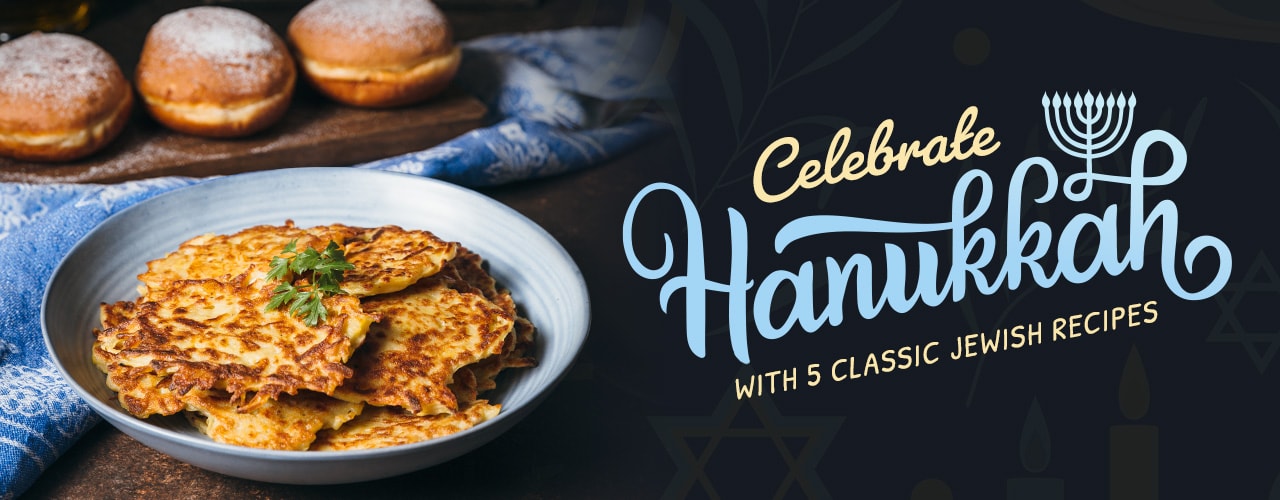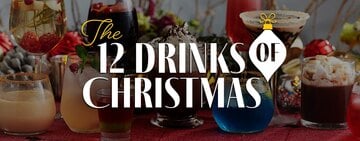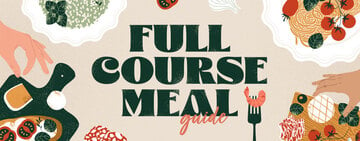Traditional Hanukkah Foods
Hanukkah is an eight-day holiday that celebrates the endurance of the Jewish religion and culture in the second century BCE. It can fall anytime between late November and late December, marking the 25th day of the month of Kislev in the Hebrew calendar.
Known as the Festival of Lights, Hanukkah is a time when friends and family gather to rejoice, exchange gifts, and enjoy an assortment of traditional Hanukkah foods. From hearty potato latkes to sweet, crispy kugel, read below to learn more about traditional Hanukkah recipes.
Hanukkah Food List
Hanukkah 2023
This year, Hanukkah starts on Thursday, December 7th and ends on Friday, December 15th.
Hanukkah Foods
Traditional Hanukkah food is composed of fried foods, savory meats, and sweet desserts. Below we go through five essential Hanukkah foods that are rooted in tradition, making them a meaningful part of your celebration.
1. Brisket

Brisket is enjoyed during many Jewish holidays besides Hanukkah, such as Rosh Hashanah and Passover. As you prepare this meal in a dutch oven or roasting pan, be sure to include a combination of flavor-enhancing seasonings. Below are some Hanukkah brisket recipe ideas:
- Create a hearty brisket stew with potatoes and carrots
- Use a variety of spices and herbs, such as fresh cracked black pepper, paprika, salt, thyme, or parsley
- Stir in prunes and apricots for a touch of sweetness
- For a modern twist, include flavorful regional barbecue sauces with sweet flavors such as mango or peach to balance out your brisket’s savory spices.
When done right, brisket is irresistibly juicy and flavorful. Since this cut of meat is served very tender, it takes a few hours to cook.
Is Brisket a Jewish Food?
Brisket became a Jewish food tradition because Kosher practices make it easier to slice brisket meat cuts, and it was historically one of the more affordable meat cuts.
2. Latkes

Latkes, also known as potato pancakes, are made from shallow-fried shredded or mashed potatoes. While latkes are a quintessential Hanukkah food, there is still plenty of room for creativity. Here are a few ways to add a twist to this classic recipe.
- Substitute traditional potatoes with sweet potatoes
- Incorporate unexpected spices such as ginger, curry, or Cajun seasoning
- Add sweet elements such as shredded coconut and dried fruits
- Include savory ingredients such as parsnips, pesto, scallions, or different types of cheeses
What to Serve with Potato Latkes
Traditionally, Latkes are served with applesauce and sour cream. For a creative twist that remains traditional, serve your potato latkes with popular Israeli spreads such as charoset, tahini, or hummus. You can even turn your latkes into a meal by serving them with hearty toppings such as smoked salmon or baharat-spiced tofu for a vegan Hanukkah menu option.
3. Kugel

Kugel is a traditional Jewish egg noodle casserole and is commonly served as a side dish. Kugel can be transformed from sweet to savory by swapping out sugar and specialty cinnamon for vegetables and spices. Consider adding a unique and tasty touch to your Kugel with the following spices, dried fruit, nuts, and other ingredients.
- Ceylon or cassia cinnamon
- Dried fruits such as raisins, craisins, pineapple, or apricots
- Apples and honey
- Pumpkin puree with cloves and maple syrup.
- Cranberries and pecans
- Cornflakes and golden raisins
Kugel is a traditional Ashkenazi Jewish dish. Some interpretations credit kugel with mystical, spiritual qualities.
4. Sufganiyot

Sufganiyot are round, deep-fried yeast dough filled with jam and sprinkled with powdered sugar, similar to paczki. The Hebrew word sufganiyot is pronounced "soof-gah-nee" and is derived from the Greek word sufan, which means "spongy" or "fried". To Western guests, this type of donut can be understood as a cross between a beignet and a jelly doughnut. Sufganiyot are an essential Hanukkah food. Below are suggestions for serving unique sufganiyot recipes this year.
- Try making donuts gluten-free or vegan to accommodate dietary restrictions.
- Fill your sufganiyot with various types of fillings, such as raspberry jam, strawberry jam, blueberry jam, pumpkin cream, lime curd, or chocolate custard.
Why Are Fried Foods Eaten for Hanukkah?
Fried foods are an important part of the traditional Hanukkah dinner because they represent the small amount of oil that miraculously burned for 8 days instead of just one when the Jews rededicated the Temple after overcoming oppression. As guests enjoy their meal, the oil used to fry the foods reminds them of the miracle their ancestors experienced centuries ago.
5. Hanukkah Gelt

Traditionally, Hanukkah gelt was money given as a present during the Jewish festival of Hanukkah. In most modern celebrations, Hanukkah gelt takes the form of a chocolate coin covered in gold foil. Whether scattered on kitchen and dining room tables during your Hanukkah celebration, reserved for prizes during games, or given as a token or gift, chocolate Hanukkah gelt is a part of many Hanukkah celebrations today.
- Change it up this year by making your own Hanukkah gelt made of dark chocolate or white chocolate.
- Use Hanukkah gelt molds to add the Star of David or a menorah to your chocolates.
Why Is Chocolate Hanukkah Gelt Given on Hanukkah?
Since the 17th century, giving money (gelt) on Hanukkah has been a tradition. It began with parents giving gelt to teachers and eventually expanded to families giving gelt to their children as gifts or rewards for Torah study. Over time, chocolate manufacturers used the concept to make chocolate gelt wrapped in gold or silver foil in small pouches that look like money bags. This act of gratitude is also recognized as a commemoration and celebration of the miracle of the oil.
Other than these customary Hanukkah foods, it's typical to include a range of other sides, like challah, large salads, Brussels sprouts, or seasonal recipes, such as fried okra and late-harvest zucchini. These dishes represent the long history of Jewish families and friends coming together and celebrating the holiday season through food. Incorporate this blend of traditional and modern flavors into your favorite Jewish recipes to provide guests with a memorable Hanukkah meal.



